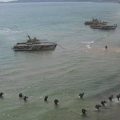
![]()
Intelligence Research Observatory
The Technical, How A Pickup Truck Influences Modern Warfare
Methodology–OSINT research
Research & Analysis-S.A. Cavanagh
“The Toyota pickup truck is instrumental to people as a humble tool you haul and tow things but, also has the power to shape the borders of the world”
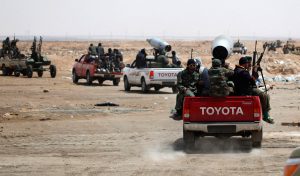
Image of a Technical Formation thought to be Libyan rebels-courtesy of The Atlantic
Background & Analysis
The Toyota Technical, a civilian patterned vehicle is without question the most important force multiplier in modern military history. Technicals have influenced how insurgencies, Special Forces & regular armies fight in the battle space. Technicals have been instrumental shaping the borders of the globe. The light gun truck reigns king of the battlefield, technicals provide fighters with agility, speed, payload, fuel efficiency, utility, & reliability. Poorly trained rag tag insurgents, pirates, rebels, terrorists and the next generation of freedom fighters have all utilized the humble Toyota pick up truck in manoeuvre warfare. Technical formations have proved that wars can be won on a budget, and whoever has the most money does not necessarily win the war. The Technical is so effective in warfare; modern militaries and spec ops have adopted the light truck for COIN operations because of its small footprint and easy logistics. The Toyota Technical has altered tactical manoeuvres and strategic doctrine. Technicals have become key tools used for conventional, guerrilla, & proxy warfare; indigenous force support and advise and assist missions. In the early run up to the first deployments in Afghanistan, US Special Forces purchased scores of Toyota Tacoma’s from showrooms in the continental USA. They added brush guards, roll bars, machine gun mounts, bumper winches, and antenna mounts; removed interior lighting, seatbelt alarms and door buzzers to make their improvised gun trucks quiet and tactical. The SF community found technicals to be so effective, that armouring companies reengineered the modest utility trucks, with hidden up armour, bulletproof glass,& run flat tires, features that come standard in expensive military pattern vehicle.
Much as the US Air Force has been rethinking coin aircraft, ground forces should be reviewing the cost benefit ratio of military pattern vehicles when something lighter will do. Resources can then be better allocated into other areas of the battle space. Why use expensive fighter jets in third world operations when there is no air defense threat present? Super Tucano and Beechcraft Wolverine turboprop light attack craft will drop bombs and deliver fire support at a fraction of the cost of fast air jets. Consider the same approach, outfitting land elements with Technicals; 266 Toyota trucks can be purchased for the cost of one tank. (War is Boring, 2013) Technicals are ideal in Third World conditions; four-wheel-drives can tackle almost any terrain. Light trucks don’t weigh much, allowing them to cross weak bridges and fragile roads that armoured vehicles can not.
The speed and agility of the technical helps overcome, the disadvantages of bad intelligence, weak leadership, and the poor planning of dispossessed nations fighting wars. Pickup trucks require no special logistical support; every country on Earth can support them. They don’t guzzle fuel and they don’t require constant maintenance. If a pickup breaks down, parts can be sourced. If no parts are available, it’s just a pickup truck. Park it and walk away. Pickups don’t require special training to operate, anyone who already knows how to drive a car can drive a truck with a machine gun bolted on the back. (War is Boring, 2013)

Chadian Soldiers in Desert Warfare-Courtesy of History of Yesterday
Consider the Great Toyota wars of Chad
Libyan forces numbered 8,000 soldiers, 300 tanks, 60 combat aircraft, Mi-24 helicopters, rocket launchers, and regular artillery pieces. Chadian National Armed Forces were composed of 10,000 unequipped soldiers. Chad forces had no aircraft, no helicopters, and no tanks. Chad’s only hope to drive the Libyans out of Aouzou territory was represented by an army of 10,000 soldiers with limited anti-tank and anti-aircraft weapons and no means of transportation. Enter the great nation of France. Viva Le France! There are no official records of why France did this, but the French Air Force delivered 400 Toyota pickup trucks to Chadian forces who skillfully implemented antiaircraft guns and Milan anti-tank guided missiles in the bed of the truck.
On January 2, 1987, Chad Army commanders deployed 3,000 Chadian troops into a brutal engagement with 1,200 Libyan soldiers supported by 400 members of the allied militia. Libyan armour formations in Fada lost 784 soldiers, 92 T-55 battle tanks, and 33 BMP-1 infantry fighting vehicles. Chad lost 18 soldiers and 3 Toyota pickup trucks. The next day the Libyan Air Force tried to annihilate the Chadian soldiers and their trucks, but all bombing attempts failed because of the mobility of the Toyota Hilux.
Later when assaulting Libyan airfields, the Chadians discovered that if they drove at high speed over the mines, they did not go off. The airbase was decimated with similar tactics that were used earlier in the Battle of Fadua. (History of Yesterday, 2020)
The Technical gun truck has demonstrated that any motivated group with some Toyotas can make a formidable adversary. The technical provides speed, mobility, and reliability. A Toyota Land Cruiser or Hilux pickup truck that can carry 20 guerrillas armed to the teeth while providing the fire power of heavy weapons in a war; that is something special. (Motorpaison, 2011)
“Technical fighting vehicles are only limited by a few factors, the imagination of the soldier and the limitations of the vehicle platform to carry weapons payload”
The Legend-Folklore, How did the Technical get its Handle?
Aid Agencies
Legend has it that the Technical got its designation from aid agencies working in Somalia in the 1990s. The organizations were not allowed to hire private military or security contractors. During the Somali civil wars the aid groups required armed protection and therefore engaged warlords to protect the humanitarian workers and the stocks of supplies being distributed. As the aid agencies were banned from the practice of hiring strongmen, the costs associated with engaging protection were hidden in expense reports as “technical assistance.”
Russian Soviet Engineers
While it is plausible, that humanitarian aid agencies are responsible for nicknaming the legendary technical; there is contrary evidence that the designation was imparted 10 years earlier by Russian weapons technicians. Russian engineers from the arms maker Tekniko were providing military equipment services in neighbouring Ethiopia. Tekniko, for some reason installed mounts for weapons systems in the cargo box of light trucks for the Somali National Movement in the 1980s while on contract in Ethiopia. The Somali National Movement was a guerrilla force established by the Isaac clans from the north-western regions of Somalia. Working from safe havens in Ethiopia the Somalia National Movement (SNM) endeavoured to remove Siad Barre, a ruling Somali dictator. (CIA-World Factbook, 2021) Ethiopian military aid subsequently came to an end, and SNM guerrillas were compelled to raid and capture stores of Somali National Army Toyota Land Cruisers, equipping them with various forms of light and medium weapons systems.
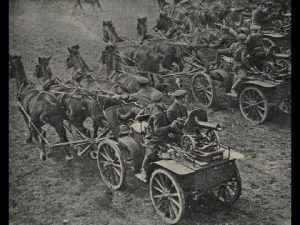
Image of a Tachanka Formation-Courtesy of YouTube
The Tachanka
The concept of the technical has been around much longer then the Somali gun trucks of the 80s. A regular civilian horse cart could be easily converted to military use and then back again as needed. Tachankas were popular during the Great War on the Eastern Front, the horse cart machine gun mounts were utilized by Russian cavalry. The use of Tachankas peaked during the Russian Civil War (1917–1920s), particularly in the peasant regions of Southern Russia and Ukraine. The name Tachanka may have evolved from the terms used to describe wheelbarrows and carriages. (Army Guide, 2013) Tachka is the Ukrainian name for a rugged and utilitarian wheelbarrow. The word tavrichanka is the term for a heavy duty carriage found in southern Ukraine and the Crimea regions.
Tachanka Tactics
Tachanka tactics were centered on taking advantage of speed to surprise the enemy. Tachankas were used before introductions of the tank or automobiles on the battlefield. Horse and wagon were the only way to provide high-speed mobility for the heavy, bulky machine guns of World War 1. The speed of the horse-drawn cart was used to quickly move the machine gun platform to a favourable firing position; enemy forces would then be fired upon before they had a chance to react. Since the machine gun pointed towards the rear of the cart, the Tachankas also provided effective suppressive fire onto pursuing enemy cavalry after raids or during retreats. Originally used by Russian and Ukrainian armies, the Tachanka was later adopted by a number of other countries; most notably the Polish Army used the gun carts during the Polish-Soviet War. Initially the horse drawn gun carriages were mostly improvised. Later the Polish Army adopted two models of factory-made horse drawn gun carts which became known as Taczankas in Poland. Production Taczankas were used during the Invasion of Poland in 1939 to provide support to cavalry squadrons. Despite a certain degree of standardisation, the Tachankas armament was, in most cases, improvised. (Army Guide, 2013)
Nicknames for the Technical
Various terms of endearment have been bestowed on the workhorse; technicals are also sometimes referred to as,
- Gunships
- Gun trucks
- Battlewagons
- Gun wagons
“Improvisation, after Invention, is second nature to man which has led to Technicals, something that anyone with basic knowledge can create with little time and money at hand “(Drive Tribe, 2020)
Before it had a Name-History of the Technical
Since ancient times, man has created mobile weapons or found ways to carry them, most notably the chariot, so it comes as no surprise that we have created weapons that are specialized for destruction such as Tanks and Bombers. Born in World War One but perfected in the hands of British Special Forces during World War Two in North Africa, Technicals have since found a unique place in modern warfare. Technicals or NSFVs (Non-Standard Fighting Vehicle) are improvised fighting vehicles typically based on a pickup truck or SUV, and can be easily modified to carry a large array of weapons ranging from a machine gun, anti-aircraft gun, anti-tank gun, mortar, rocket launchers, and recoilless rifle. This, combined with the mobility of the vehicle makes them a popular choice for insurgencies and unconventional warfare. While Technicals such as modified Model T Fords and Tachankas saw use in World War One, it wasn’t until the use of Chevrolet Patrol Trucks and Jeeps by British Special Forces in North Africa that they became a popular military weapon. Their use helped the Commonwealth forces to outfox the Desert Fox in mobile warfare. At times they used to drive the vehicles right into the enemy airfield with their guns blazing, destroying any aircraft that was parked there; it was this experience that led to the creation and adoption of Land Rover. (Drive Tribe, 2020)
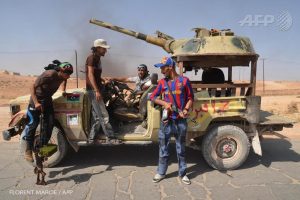
Image of a BMP technical-Courtesy of AFP via Reddit
Types of weapons mounted on Technicals
The types of weapons that can be adapted to the Technicals are only limited by imagination and the vehicles ability to carry the payload. There are exceptions to this rule however; there have been some very creative adaptations of heavy hardware mounted on the light utility truck. Captured BMP turrets have been placed on some lightweight frames as a novel approach or as battlefield experiment. There is no data available that tells us if the BMP turret mount was effective or simply a means of propaganda. There is evidence, that if a heavier duty truck was available, oversized weapons were attached and designated as heavy technicals.
Technicals are typically fitted with trainable heavy machine guns, installed on the tripod in the rear cargo area. Also there can be numerous improvised modifications, outfitting trucks with anti-aircraft guns and missiles, anti-tank missiles and recoilless rifles. Even salvaged artillery rocket systems and helicopter rocket pods are mounted on pickups. The weapons can vary widely; some technicals are fitted with add-on steel plates, which provide some degree of protection for the gunner. (Military Today, 2006-2021)
Inventory of Weapons Known to be Fitted on Technicals
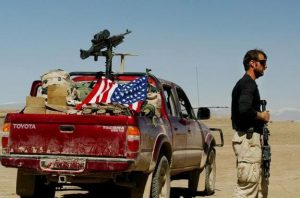
Image of Technical with General Purpose Machine Gun-courtesy of Medium
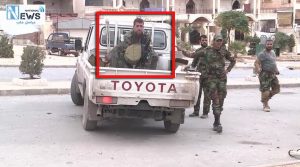
Image of Technical thought to be Syrian Army, mounted with AGS-17 Plamya automatic grenade launchers-courtesy of South Front
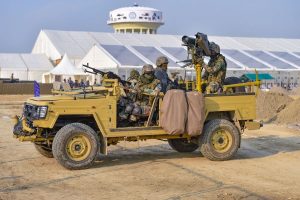
Image thought to be a MILAN anti-tank guided missile system mounted on an Indian light strike vehicle-courtesy of GLIBES Quick Media
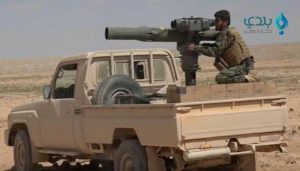
Image of TOW missile system mounted on a Technical, AKA TOW-yota-courtesy of Reddit

Image of Recoilless Rifle Technical-courtesy of Flat Land Gallery

Image of a technical Anti-aircraft gun-courtesy of Flat Land Gallery
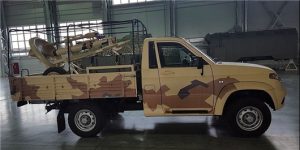
Image of a Russian technical UAZ Patriot pickup truck with 120mm mortar tube mount-courtesy of Fars News Agency
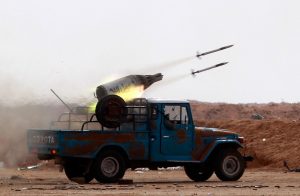
Image Technical with multiple rocket launchers, repurposed helicopter rocket pod-courtesy of Reddit
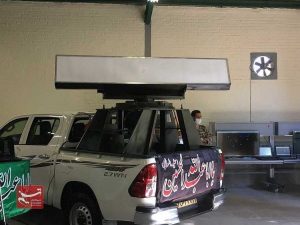
Image of Technical with Iranian Kashef-99 D Radar systems-Image courtesy of Reddit
The Great Toyota Wars
Video courtesy of YouTube
The Great Toyota War of Chad
Adapted from an Article Written by Marcia Panait of Autorevolution
No one would have ever guessed that the Toyota pickup truck would come to play an important role in warfare history. This is the little-known story of how an army comprising 400 Toyota pickups outgunned, outsmarted, and outmanoeuvred a superior force equipped with tanks and aircraft.
The story of the Toyota War starts in 1972, the year when Libya gained the Aouzou Strip under obscure terms. The apple of discord was a strip of land in northern Chad which lies along the border with Libya.
Lured by the prospect of finding uranium deposits for the country’s atomic energy development program, Libya moved its troops and established an airbase just north of Aouzou, after which the Libyan army set up a civil administration there. Felix Malloum, the President of the Republic of Chad, brought the issue of occupation before the UN and that’s how the situation became bloody hot for Muammar Gaddafi and the Libyan army.
To that end, the Chadian-Libyan conflict officially started in 1978. Four Libyan interventions in the Republic of Chad took place in 1978, 1979, 1980 to 1981, and 1983 to 1987. In all of these interventions, Gaddafi poured money into numerous factions participating in the war. December 16, 1986, observers saw the Libyan-Chadian war enter its closing phase – the Toyota War.
Libyan forces numbered 8,000 soldiers, 300 tanks, 60 combat aircraft, Mi-24 helicopters, rocket launchers, and regular artillery pieces. This formidable force was marred by low morale among the troops and inadequate knowledge of the region. The Libyans had to fight against the Chadian National Armed Forces, composed of 10,000 soldiers which were unequipped. Chadian forces had no aircraft, no helicopters, and no tanks. Chad’s only hope to drive the Libyans out of Aouzou was represented by 10,000 soldiers with limited anti-tank and anti-aircraft weapons and no means of transportation.
At the beginning of 1987, though, the tides of war were about to turn. The French Air Force helped Chad by providing its 10,000-strong army with around 400 Toyota pickups. There are no official records on why France decided to give Chad Toyota pickup trucks instead of proper war machines, likely they were cheaper than Humvees, more reliable than tanks, and easier to operate than aircraft. The reliability and durability of the Toyota pickup truck were enough to give someone an idea – why not install antiaircraft and MILAN anti-tank guided missiles in the truck bed?
That’s how the final phase of the Chadian-Libyan conflict came to be known as the Toyota War. The turning point of the conflict is the battle of Fada. On January 2, 1987, Hassan Djamous, Commander in Chief of the Chadian Army and cousin of the current Chadian President, deployed 3,000 of his men in the battle.
In the brutal engagement with 1,200 Libyan soldiers and 400 members of the Democratic Revolutionary Council militia, the Chadian army and its Toyota pickups made mincemeat of the Libyan stronghold in Fada. At the end of the day, the Libyan armoured brigade in Fada had lost 784 soldiers, 92 T-55 battle tanks, and 33 BMP-1 infantry fighting vehicles.
Chadian losses were minimal: 18 soldiers and 3 Toyota pickup trucks. January 3 and 4 saw the Libyan Air Force try to annihilate the Chadian soldiers and their trucks, but all bombing attempts failed thanks to the outstanding mobility of the Toyota Hilux. A month after this epic moment in military history, a ceasefire was agreed upon. As a conclusion to the war, the International Court of Justice ended the Libyan claim over the Aouzou Strip in 1994.
Forget those images of ISIS terrorists shooting their AK-47s in the sky from the bed of Toyota pickup trucks. Forget the notion of terrorism for one single minute and concentrate on Chad’s victory over Libya. Hadn’t it been for the pickup trucks, things would have taken a turn for the worse for Chad and the free world alike. Most importantly, the battle of Fada is the first military victory to employ light trucks armed with weapons. While there may be some resemblance to the raids conducted by the British Army’s Long Range Desert Group in World War II, the Toyota War is much more way-out than conventional warfare.
Thanks to his service in the Chadian army and his brilliant strategy to use Toyota pickup trucks to outmanoeuvre heavily armoured Russian tanks, Commander Hassan Djamous proved that firepower alone doesn’t win a war.
The Toyota pickup truck is instrumental to people as a humble tool you haul and tow things but, also has the power to shape the borders of the world. (Auto Evolution, 2016)
BBC Top Gear Killing a Toyota
Durable, Dependable, Tough-Here is why the Toyota is Suitable for War
Toyotas stand up to more than just normal vehicular wear and tear, in 2006; the British TV show “Top Gear” conducted an experiment that illustrated this.
The show’s producers bought an 18-year-old Hilux diesel with 190,000 miles on the odometer for $1,500. They then crashed it into a tree, submerged it in the ocean for five hours, dropped it from about 10 feet, tried to crush it under an RV, drove it through a portable building, hit it with a wrecking ball, and set it on fire.
Finally, they placed it on top of a 240-foot tower block that was then destroyed in a controlled demolition. When they dug it out of the rubble, all it took to get it running again was hammers, wrenches, and WD-40. They didn’t even need spare parts. (Business Insider, 2015)
“These vehicles have earned a great reputation for three fundamental characteristics: agility-not armour, speed, load capacity and reliability. A Land Cruiser Pick-up (or Hilux) can carry 20 guerrillas armed to the teeth or carry an anti-tank, anti-aircraft weapon, a heavy machine gun against infantry. That in a war is quite important”
Other Great Reasons to Outfit Forces with Technicals
- These vehicles have earned a great reputation for three fundamental characteristics: agility-not armour, speed, load capacity and reliability. A Land Cruiser Pick-up (or Hilux) can carry 20 guerrillas armed to the teeth or carry an anti-tank, anti-aircraft weapon, a heavy machine gun against infantry. That in a war is quite important. (Motorpaison, 2011)
- In March 1987, Chadian forces attacked a Libyan airbase at Ouadi Doum which was a heavily fortified with 5,000 soldiers and protected with Soviet munitions a minefield. The Chadians discovered that if they drove at high speed over the mines, they did not go off. The airbase fell with similar tactics that were used in the Battle of Fadua. (History of Yesterday, 2020)
- The Toyota costs a fraction as much as a modern main battle tank. In fact, you can buy 266 of them for the cost of just one tank. Plus it’s more dependable than a tank—and easier to maintain. (War is Boring, 2013)
- Pickup trucks’ mobility makes them ideal for Third World warfare. Four-wheel-drives can tackle almost any terrain. Light trucks don’t weigh much, allowing them to cross weak bridges and fragile roads that would be impassable to armoured vehicles weighing tens of tons.
- The speed of a pickup is handy on the battlefield, helping fighters overcome those other hallmarks of Third World warfare: bad intelligence, weak leadership, poor planning.
- Pickup trucks require no special logistical support; any country with gas stations—that is, every country on Earth—can support them. They don’t guzzle fuel like heavy military vehicles and they don’t require constant maintenance. If a pickup breaks down, parts probably can be found. And if they can’t, well, it’s just a pickup truck. Park it. Walk away.
- Pickups don’t require special training to operate. Unlike armoured vehicles, anyone who already knows how to drive a car can drive a truck with a machine gun bolted on the back. (War is Boring, 2013)
A Lightfoot Print & Easy Logistics
Why the Lowly Technical Oftentimes is More Appropriate then Military Pattern Vehicles
- The Toyota pickup should have no place on the modern battlefield. It’s seemingly the very opposite of a modern vehicle of war. It’s un-armoured, unarmed in its original format, inexpensive and didn’t originate from some billion-dollar development program run by Lockheed Martin. And yet for those very reasons, the Toyota thrives on battlefields in poor countries. The civilian truck has struck an ideal balance between convenience, economic reality and the demands of local terrain. The proliferation of the light pickup truck in Third World campaigns is a reminder that people will use what they can get their hands on to get a job done—and that adaptability is one of the most important traits of any weapon.
Easy to Modify
- There are many reasons why Technicals have gained popularity in warfare. As mentioned earlier they are incredibly easy to modify with various weapons, combined with the off-road capabilities of pickup vehicles they are comparably easier to use than a tank or specialized fighting vehicle.
Easy to Maintain
- Moreover, due to their nature, technicals are far easier to maintain than AFVs and have need of less logistical support.
Burn Less Fuel
- Mileage is also a big concern
- Tanks like the M1A2 Abrams and Challenger 2 give about 0.6 mpg and 0.38 mpg respectively
- HMMWVs can give around 10 mpg to 14 mpg
- So for comparison a modern Toyota Hilux can give 39 mpg
- While this might not seem like much, when fighting a war in the middle of nowhere resources like fuel becomes really scarce and thus have a large impact on tactics
Reliability
- The same concern also lies with reliability; large armoured vehicles need more parts replacement compared to lighter vehicles and are more prone to breakdown
Stealth, Camouflage & Signature
- Technicals are also smaller than tanks and AFVs and thus stealthier. There were many times when British Special Forces in North African remained unnoticed by recon aircraft and scouts. They are also far easier to camouflage than large vehicles. Noise and Dust signature is also a concern as large vehicles create far more of both. (Drive Tribe, 2020)
Who Uses Technicals?
From the deserts of the African Maghreb to the mountains of Afghanistan, warriors from tribesmen to American Special Forces have chosen the Toyota pickup truck as their un-armoured personnel carrier of choice

Image thought to be US Special Forces operating in Syria-courtesy of Time
USA- Special Forces
After 9/11, U.S. Special Forces quickly deployed to Afghanistan but found themselves without suitable transportation. They needed lightweight, highly mobile vehicles capable of operating with a minimum of support. The rest of the U.S. military was the last place in the world to look for help. So the Special Forces went shopping in Toyota showrooms in North Carolina and Kentucky. Toyota Tacoma trucks were modified for Afghanistan by adding roll cages, machine gun mounts, bumper winches, brush guards and antenna mounts. Infrared headlamps replaced standard headlamps. Some vehicles even received Blue Force Trackers, the U.S. Army’s digital position-reporting system.
Special Forces liked the Tacoma’s because they were, in their own way, stealthy. Toyota pickup trucks have the benefit of not looking very military, which is handy for blending in with civilian traffic. The gasoline-engine models bought off American lots were quieter than the diesel engines used by local trucks. The trucks were made even stealthier with the removal of door buzzers, seat belt warnings and virtually all lights. The last thing anyone in combat needed was a warning that he didn’t have his seat belt on, or an overhead light automatically turning on in the dark.
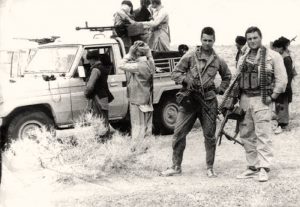
Image thought to be of Soviet Spetsnaz operating in Afghanistan using a technical-Image of unknown origin
Soviet Union
In the Soviet-Afghan War, even Soviet soldiers were not averse to the capitalist technology of Toyota. There are various photographs of Soviet troops, primarily Spetsnaz special forces, using the Hilux or Land Cruisers mounted with classic Soviet-made weaponry like the DShK. (Young Pioneer Tours, 2021)

Image Peshmerga fighters in a Technical-courtesy of Reddit
Peshmerga
Peshmerga fighters have tested the versatility of these vehicles, relying on their agility to surround and attack ISIS forces. (Geopolitica, 2014)
Nonlethal Aid, Governments that Provide Technicals
- Toyotas or other light trucks and SUVs are easily acquired, legally or otherwise
- Often they are even given to armed groups by foreign governments as “nonlethal aid”
- The U.S. State Department has donated pickups to the rebel Free Syrian Army
- France provided 400 Toyotas to Chad
Heavy Technicals
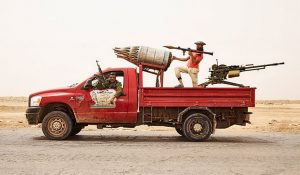
Image of Heavy Technical-courtesy of Drive Tribe
Vehicles the US Special Forces termed the `heavy technical’ were mainly Mercedes and Spanish Pegaso trucks with AA cannon mounted on the flatbed; the ZPU-1 and ZPU-2, the ZU-23-2 and even the ancient but still-deadly World War II-era 37mm M1939 all proved popular
In Chechnya, insurgents operated a limited number of ZPU-2 and ZPU-4 AA cannon mounted on the flatbeds of trucks in the mountains surrounding Grozny
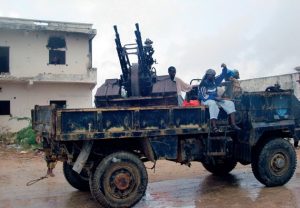
Image of a four-barrelled 14.5mm ZPU-4-equipped Spanish-made 3046 Pegasus.-based `heavy technical’ in Mogadishu-courtesy of Weapons & Warfare
Heavy technicals mounting a dizzying array of AA guns are in use as direct-fire artillery to shoot-in ground assaults, along with the familiar ZUs and ZPUs, 20mm Hispano-Suiza HS. 820s, S-60s and even Romanian twin-barrel 30mm Model 80 cannons have all made an appearance. Even Russian Gryazev-Shipunov 23mm and 30mm cannons have been pillaged from former Libyan Air Force aircraft and affixed to a range of light trucks using homemade mounts, on Libyan technicals

Image of Amal M35 `heavy technical’ or `gun-truck’ mounting a 23mm ZU-23-2 AA cannon, West Beirut-courtesy of Weapons & Warfare

Image of BMP Heavy Technical-courtesy of Drive Tribe
The Libyans were the first to improvise components from BMP-1s. Along with the use of actual BMP-1 turrets, often with hillbilly armour used to shroud the frame supporting the turret, the 73mm gun itself has been retrieved from destroyed BMPs and mounted in a clumsy mechanism bolted to the tray bed of Chinese ZX pick-ups as a kind of technical mounted cannon. Its accuracy can only be guessed. (Weapons & Warfare, 2019)
Not Just Toyota, Other Brands of Technicals
- Toyota Hilux and Land Cruiser are by far the most popular choice as Technicals
- Vehicles from Ford, Chevrolet, GMC, Isuzu, Mitsubishi, Land Rover, and Nissan come close behind
- Chinese pickups are also being seen in the conflict in Syria and Africa (Drive Tribe, 2020)
- Civilian CJ-series Jeeps were also very common Technicals
- American Dodge and Chevrolet pick-ups mounting AA guns including larger Chevrolet C20 flatbeds sported the formidable four-barrel ZPU-4
- US-made M35s, the famous `deuce and a half’, were modified to mount heavy AA platforms like the ZPU-4
- Lebanese Forces militia deployed large numbers of Iranian-made Keohwa M-5GA1 Jeeps mounting the M40 RCL, the Milan ATGM and the Chinese Type 63 12-barrelled rocket launcher
- Any vehicle can become a Technical so long as it can carry a large load and go off-road
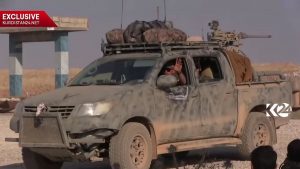
Image thought to be US Special Forces operating in Syria using a commercial built version of a Toyota Technical-Image courtesy of Kurdistan 24 via Twitter
Technicals Go Commercial
- While conventional armies generally don’t use Technicals it also means that they stick out like a sore thumb when deployed in Africa and The Middle East
- This has led U.S. Special Operations Command to modify Toyota Land Cruisers, Hiluxes and Ford Rangers with additional armour and equipment so that they can blend in with other vehicles
- Similarly, Navistar Defense sells SOTV-B (Special Operations Tactical Vehicle B) which may look like any other pickup truck but underneath lies protection and equipment similar to a Military light utility vehicle (War is Boring, 2013)
Technicals in the Wild, Where Have Technicals Been Spotted in Warfare?
- Yemini Civil War
- Donbas war
- Syrian civil war
- Libyan civil war
- Lebanon
- Darfur
- Iraq
- Afghanistan
- Somali civil war
- Chadian Libyan conflict
- Western Sahara
- Nicaragua
- Ethiopia
- Rwanda
- Liberia
- Democratic Republic of the Congo
- Sudan
- Mexico
Technical Influence on Warfare & Doctrine
The Chadians used a combination of diversionary tactics and raids to demoralize and defeat Libyan troops. Columns of Chadian army Toyotas would appear in one direction, drawing the attention of the Libyans. The main Chadian force would then approach from the opposite direction and attack with missiles, destroying the previously invulnerable Libyan tanks.
At the Battle of Fada, 4,000 to 5,000 Chadian troops in Toyota pickup trucks defeated a Libyan armoured brigade, killing 784 Libyans and their allies. Nearly 100 Libyan tanks and more than 30 armoured personnel carriers were destroyed in the fighting. Chadian losses were a mere 18 troops and three Toyotas (War is Boring, 2013)
The Toyota example is one of many that clearly signals a need for conventional state armies to adapt their logistical capabilities to better match the challenges of non-conventional warfare and insurgencies; the primary forms of conflict in which our nations are today engaged. The first lesson is clearly that the traditional focus on high power and the availability of resources is poorly suited to respond to contemporary insurgencies and military engagement with primarily non-state entities. Rather, there is a growing need for logistical versatility, combining both attack power and high manoeuvrability.
The Toyota issue is an interesting example that illustrates how groups like Daesh have been able to mobilize an easily accessible, relatively non-expensive market commodity that has proven to be effective in lending the group precisely the kind of logistical aid required to successfully wage its insurgency
What Do the Strategy Experts Say About the Lowly Toyota Technical?
- “The Toyota Hilux is everywhere,” Andrew Exum, a former US Army Ranger who is now the US deputy assistant secretary of defense for Middle East policy, “It’s the vehicular equivalent of the AK-47. It’s ubiquitous to insurgent warfare, and actually, recently, also counterinsurgent warfare (Business Insider, 2015)
- The truck is “fast, manoeuvrable, and packs a big punch when mounted with a 50-caliber machine gun that easily defeats body armour on soldiers and penetrates lightly armoured vehicles as well,” Alastair Finlan, who specializes in strategic studies at Aberystwyth University in the UK (Business Insider, 2015)
- An advisor to the Syrian National Coalition said the Toyota Hilux was an “important force multiplier” specifically requested by the Free Syrian Army (Quartz, 2015)
“The best defense was agility, not armour”
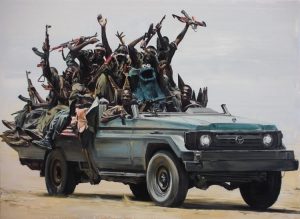
Image courtesy of Alchetron

![]()
Resources
Getting technical: Toyota pickups, anti-aircraft weapons and the Libyan Revolution-The Conversation-Mat Hardy (2011) https://theconversation.com/getting-technical-toyota-pickups-anti-aircraft-weapons-and-the-libyan-revolution-3643
The Toyota Pickup Truck Is So Dependable, a War Was Named After It-Autoevolution-Mircea Panait (2016) https://www.autoevolution.com/news/the-toyota-pickup-truck-is-so-dependable-a-war-was-named-after-it-104487.html
The Great Toyota War-History of Yesterday-Sam Simon (2021) https://historyofyesterday.com/the-great-toyota-war-52a22751b2c1
The Toyota Pickup Truck Is the War Chariot of the Third World-War is Boring-KYLE MIZOKAMI (2013) https://medium.com/war-is-boring/the-toyota-pickup-truck-is-the-war-chariot-of-the-third-world-ea4a121e948b
Why Are Toyota Trucks so Common in Wars in the Middle East? Young Pioneer Tours- Joel Vostok (2021) https://www.youngpioneertours.com/why-are-toyota-trucks-so-common-in-wars-in-the-middle-east/
HOW A PICK-UP TRUCK BECAME A WAR MACHINE-Drive Tribe- Rishav Dutta (2020) https://drivetribe.com/p/how-a-pick-up-truck-became-a-war-R1sSRUXHSM2YbdbT103xYQ?iid=GrO5b-LeRaaf_wDh2MtCGw
Technicals, Light Utility Vehicles-Military Today-Staff Writers (2021) http://www.military-today.com/trucks/technicals.htm
Technicals: the vehicles that changed the asymmetric conflicts-Geopolitica.info-di Matteo Latorraca (2014) https://www.geopolitica.info/technicals/
ZSU Truck Technicals-Weapons and Warfare-History and Hardware of Warfare-Staff Writer (2019) https://weaponsandwarfare.com/2019/01/07/zsu-truck-technicals/
These Toyota trucks are popular with terrorists — here’s why-Business Insider-Pamela Engel (2015) https://www.businessinsider.com/why-isis-uses-toyota-trucks-2015-10
The dark and warlike side of the Toyota Land Cruiser (Translated Version) -Motor Pasion- JAVIER COSTAS (2011) https://www.motorpasion.com/toyota/un-poquito-de-historia-la-guerra-de-los-toyota
CIA World Factbook-Government of the USA-Staff Writers (2021) https://www.cia.gov/the-world-factbook/countries/somalia/ https://www.cia.gov/the-world-factbook/countries/somalia/#military-and-security
TACHANKA, Term of the day-Army Guide- Sergyi Way (2013) http://www.army-guide.com/eng/article/article_2623.html
How did the Toyota pickup become terrorists’ favorite truck? Quartz- Amy X. Wang (2015) https://qz.com/519171/how-did-the-toyota-pickup-become-terrorists-favorite-truck/
Toyota wars and the next generation in counter insurgency strategies- Universidad de Navarra-Ignacio Yárnoz (No Date) https://www.unav.edu/web/global-affairs/detalle/-/blogs/toyota-wars-and-the-next-generation-in-counter-insurgency-strategies
Editing Services and Intelligence Collection, Provided by Chuck Stevens & Milena Castulovich




